This post contains affiliate links, which means I may earn a commission if you purchase through those links (at no extra cost to you).
I grew up making Orange Marmalade the old-fashioned way: soaking citrus overnight and boiling it rigorously to extract the natural pectin in the rind. When you follow my technique, you don’t need to add any store-bought pectin, and you get the best, cleanest-tasting marmalade.
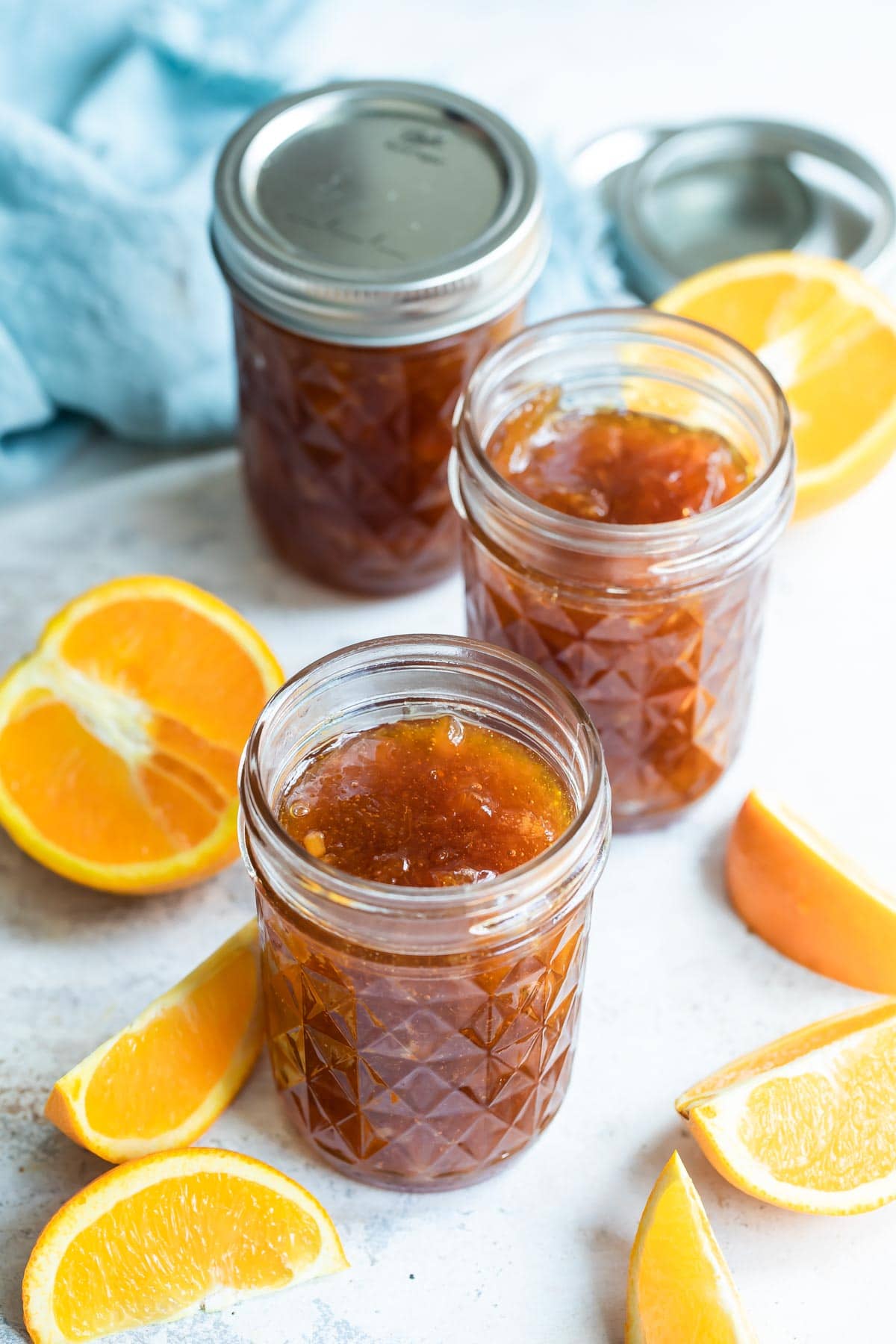
Nearly 1,000 5-star reviews prove this unfussy technique is simple and easy to follow. I also include my handy “cold plate test” so you can know for sure whether your marmalade is done or needs a little bit more time on the stove.
Home cooks everywhere are putting their abundant citrus to use to make their own homemade marmalade, and now you can, too. This recipe makes about 3 quarts total, or 12 (8 ounce jars). It freezes beautifully or you can process it in a water bath for canning.
Table of Contents
Marmalade Ingredients
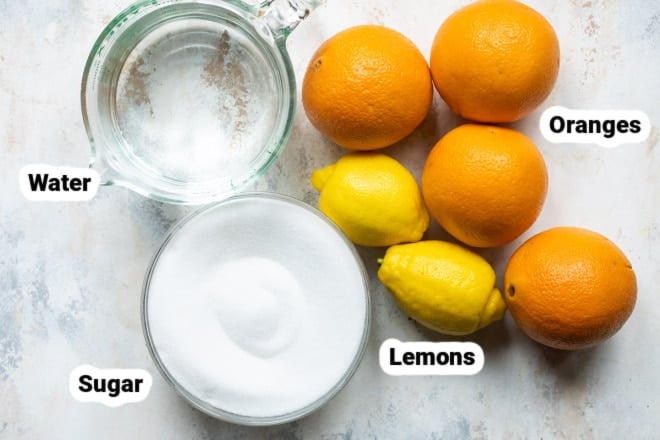
At a Glance: Here is a quick snapshot of what ingredients are in this recipe.
Please see the recipe card below for specific quantities.
- Oranges: This recipe is made with regular seedless oranges. You can definitely substitute Seville oranges if you can find them. They are only in season from the end of January to mid-February, but they have an intense flavor that is ideal for marmalade.
How to make Orange Marmalade
- Using a sharp knife, cut oranges and lemons in half crosswise, then into very thin half-moon slices. Discard any seeds. In a large pot (stainless steel), add the sliced oranges, lemons, and any fruit juice.
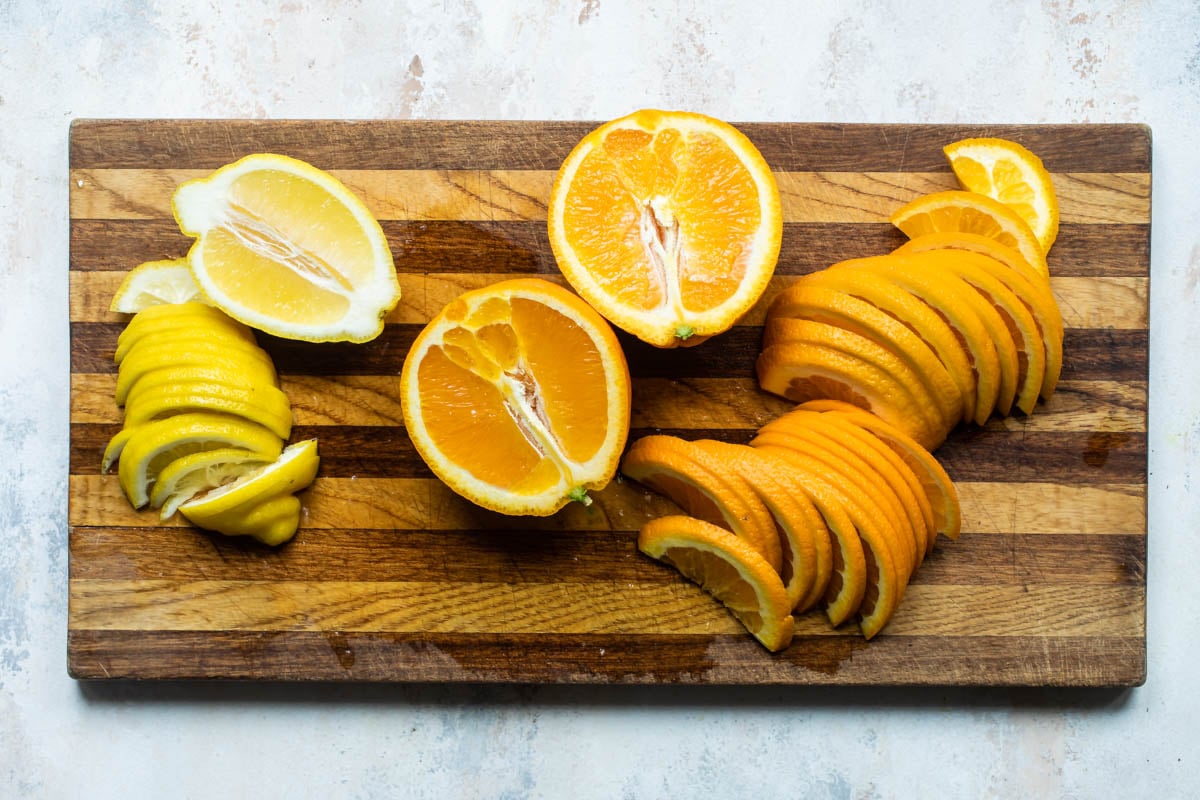
- Add water and bring the mixture to a boil over medium heat, stirring often. Remove from the heat and stir in the sugar until it dissolves. Cover and let stand overnight at room temperature.
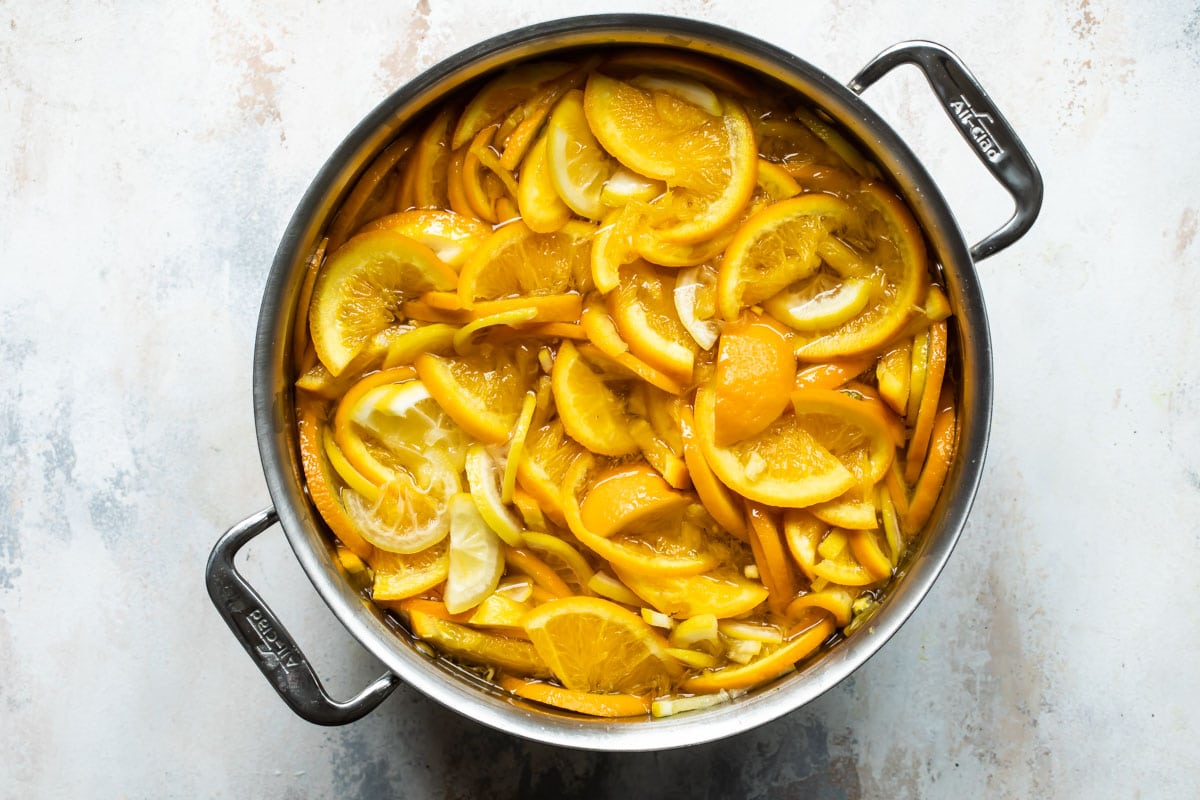
- The next day, bring the mixture back to a boil in the pot or saucepan. Reduce heat to low and simmer uncovered for 2 hours. Turn heat up to medium and boil gently, stirring often, for another 30 minutes. Skim off any foam that forms on the top. Cook until it reaches 220 degrees on a candy thermometer (you must hit this temperature for the natural pectin to gel with the sugar).
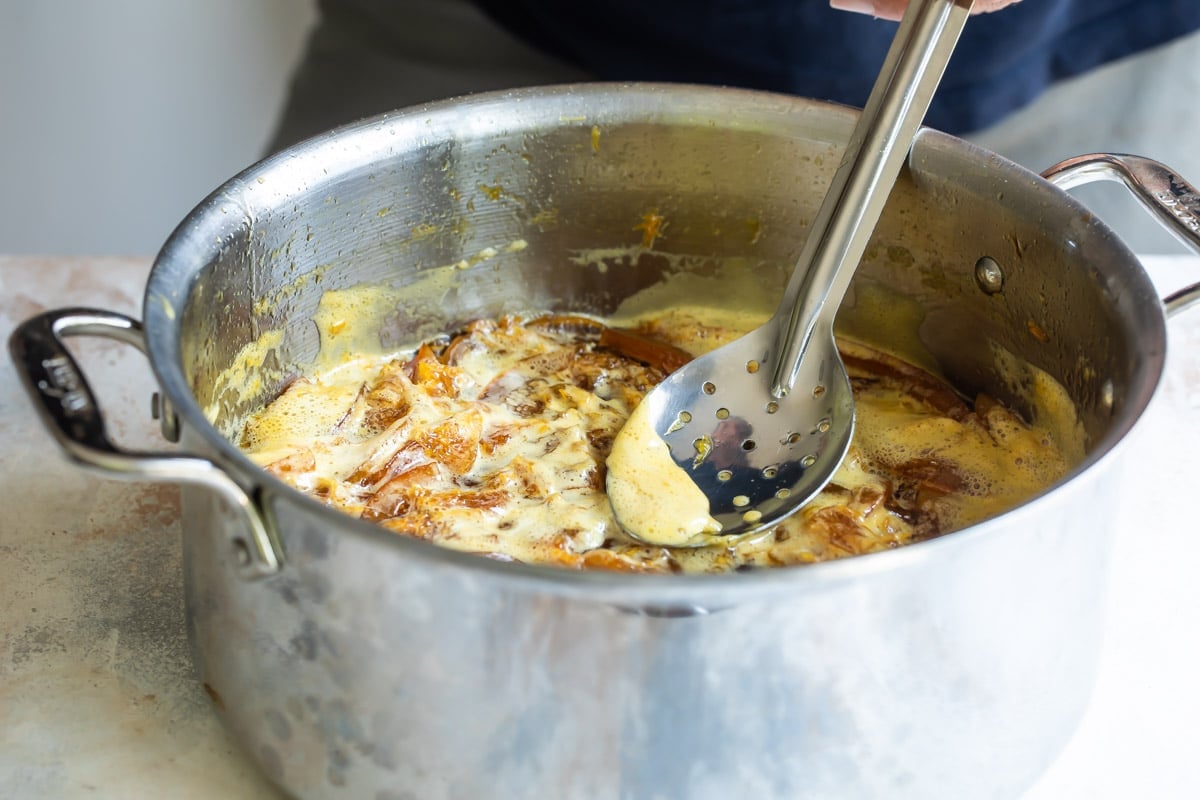
- To test if the marmalade is ready, place a small amount on a plate and refrigerate it until it’s cool but not cold. If it’s firm (neither runny nor hard), it’s ready. It will be a golden orange color. If it’s still runny, continue cooking it; if it’s hard, add a bit more water.
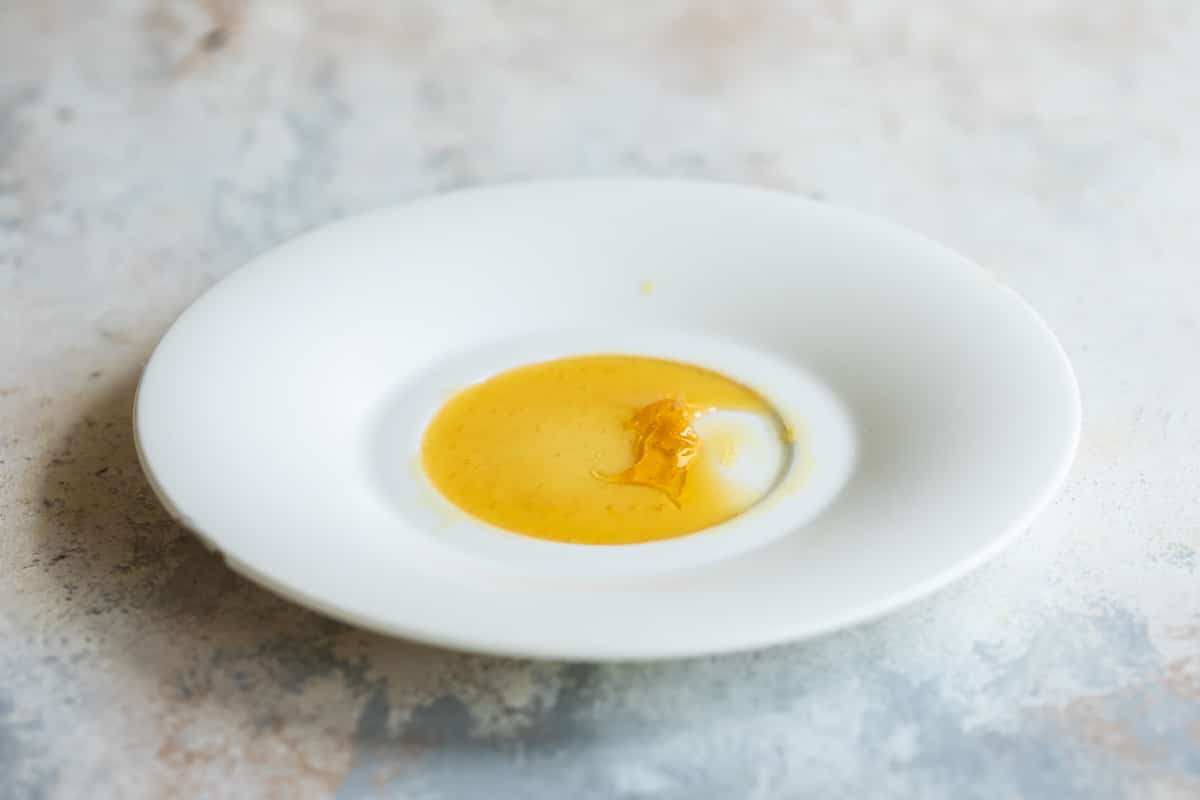
- Pour or ladle the marmalade into clean hot mason jars (I use this wide-mouth jar funnel for this recipe and so many others). Wipe the rims thoroughly with a clean damp paper towel, and seal with the lids. Chill in the refrigerator. It may take 24-48 hours for the natural pectin to set up properly.
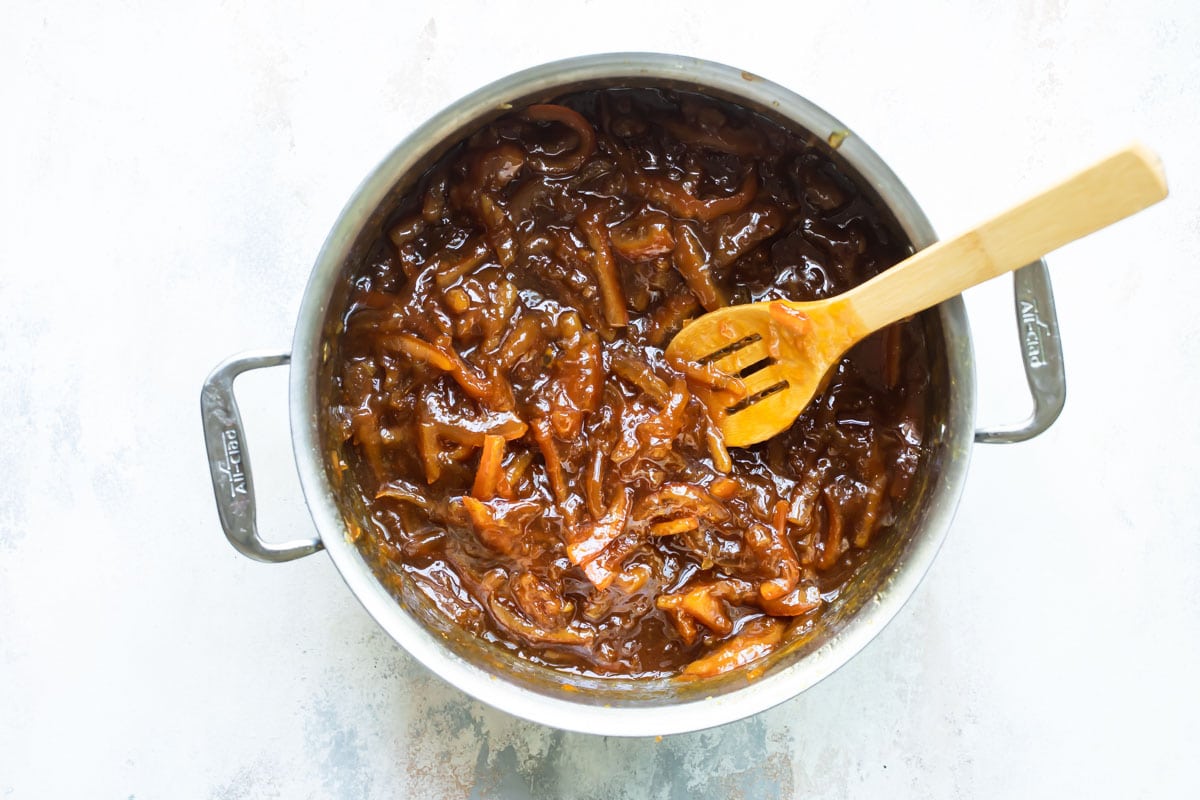
Orange Marmalade Recipe Variations
- Pectin: While many jam and jelly recipes require added pectin, you don’t need to add any here. Pectin is naturally concentrated in the pith of the orange (the bitter white part under the peel). This recipe coaxes out that natural pectin by letting the citrus soak overnight and then boiling it rapidly until enough water has evaporated that the mixture can reach 220 degrees.
- Agave nectar: Agave cannot penetrate and sweeten the peel as well as sugar can. When I tested it, the consistency was fine, but the rind tasted like raw rind. I don’t recommend this substitution.
- Low sugar: I haven’t tested low-sugar/alternative sweeteners in this recipe other than agave as listed above nor have I tweaked the amount of sugar in the recipe. I recommend seeking out recipes from experts in that area.
- Slow cooker: While it is technically possible to make marmalade in your slow cooker, it really depends on the power of your appliance. I no longer recommend that method because it isn’t reliable enough.
- Instant pot: Even with an overnight soak, the IP doesn’t break down the rind sufficiently. I don’t recommend this method.
Marmalade Recipe Tips
- Yield: This recipe makes about 3 quarts (96 ounces) of marmalade.
- If using 1/2-pint (8 ounce) jars, you’ll need 12.
- If using 1 pint (16 ounce) jars, you’ll need 6.
- If using the tiny jelly jars (4 ounce), you’ll need 24.
- Cold-plate test: To test if your marmalade is ready, spoon some hot marmalade on to a small plate and put it in the freezer to chill, or spoon some over an icy cold plate fresh from the freezer. If the mixture wrinkles slightly when you draw a spoon or finger across it, it has reached the setting point and is ready to go! If not, keep boiling and make sure the temperature reaches 220 degrees.
- Set-up time: Orange marmalade takes 24-48 hours for the natural pectin to set up completely. If it’s is still a little runny looking when it cools, check again in a day or two.
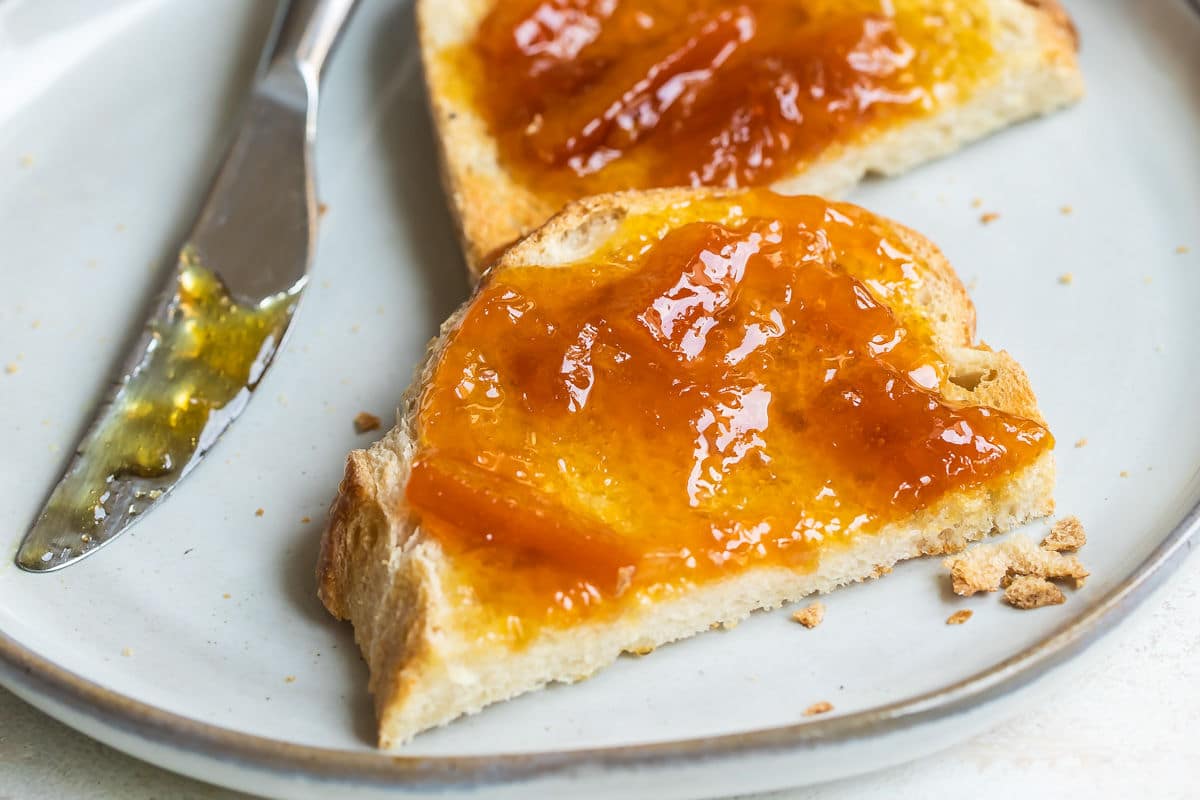
Storing and Canning Orange Marmalade
Storage: Store covered in the refrigerator for up to 1 month.
Freezer: Pack in freezer-safe containers or jars leaving 1/2-inch of headspace for expansion. Label, date, and freeze for up to 3 months. Thaw overnight in the refrigerator.
Canning: If putting up for storage, use a hot water or steam canner with a rack to properly seal lids on canning jars according to canning instructions. Otherwise, refrigerate and use within the month. Or, freeze for up to 3 months.
Frequently Asked Questions
Pectin is naturally concentrated in the pith of the orange (the bitter white part under the peel), so you don’t need to add any here. This recipe coaxes out that natural pectin by letting the citrus soak overnight and then boiling it rapidly until enough water has evaporated that the mixture can reach 220 degrees.
While it is technically possible to make marmalade in your slow cooker, it really depends on the power of your appliance. I no longer recommend that method because it isn’t reliable enough.
Even with an overnight soak, the IP doesn’t break down the rind sufficiently. I don’t recommend this method.
Agave cannot penetrate and sweeten the peel as well as sugar can. When I tested it, the consistency was fine, but the rind tasted like raw rind. I don’t recommend this substitution.
I don’t recommend making this recipe in a regular cast iron pan. It should be made in a non-reactive pan. Enameled cast iron, stainless steel, and non-stick are best and will not affect the color or taste of the marmalade
More fruit recipes
Pie and Tart Recipes
Fresh Fruit Tart
Fruit Dessert Recipes
Apple Crisp with Oatmeal
Cake Recipes
Lemon Bundt Cake Recipe
Muffins and Quick Breads
Banana Muffins
Join Us

Orange Marmalade
Equipment
- Jar funnel (for wide mouth jars)
Ingredients
- 4 large seedless oranges scrubbed clean (about 3 pounds or 8 cups slices, see note 1)
- 2 lemons (about ½ pound or 1 cup slices)
- 8 cups water
- 8 cups granulated sugar
Instructions
- Cut oranges and lemons in half crosswise, then into very thin half-moon slices. Discard any seeds. In a large stainless steel pot, add the sliced oranges, lemons, and any accumulated juices.
- Add water and bring the mixture to a boil, stirring often. Remove from the heat and stir in the sugar until it dissolves. Cover and let stand overnight at room temperature.
- The next day, bring the mixture back to a boil. Reduce heat to low and simmer uncovered for 2 hours. Turn heat up to medium and boil gently, stirring often, for another 30 minutes.
- Skim off any foam that forms on the top. Cook the marmalade until it reaches 220 degrees (you must hit this temperature for the natural pectin to gel with the sugar).
- To test if the marmalade is ready, place a small amount on a plate and refrigerate it until it's cool but not cold (see note 4). If it's firm (neither runny nor hard), it's ready. It will be a golden orange color. If the marmalade is runny, continue cooking it; if it's hard, add a bit more water.
- Pour the marmalade into clean hot mason jars; wipe the rims thoroughly with a clean damp paper towel, and seal with the lids. Chill in the refrigerator. It may take 24-48 hours for the natural pectin to set up properly.
Recipe Video
Notes
- Oranges: This recipe is made with regular seedless oranges. You can definitely substitute Seville oranges if you can find them. They are only in season from the end of January to mid-February, but they have an intense flavor that is ideal for marmalade.
- Yield: This recipe makes about 3 quarts (96 ounces) of marmalade.
- If using 1/2-pint (8 ounce) jars, you’ll need 12.
- If using 1 pint (16 ounce) jars, you’ll need 6.
- If using the tiny jelly jars (4 ounce), you’ll need 24.
- Storage: Store covered in the refrigerator for up to 1 month.
- Cold-plate test: To test if your marmalade is ready, spoon some hot marmalade on to a plate and put it in the freezer to chill, or spoon some over an icy cold plate fresh from the freezer. If the mixture wrinkles slightly when you draw a spoon or finger across it, it has reached the setting point and is ready to go! If not, keep boiling and make sure the temperature reaches 220 degrees.




Can this be doubled?
Hi Quirina! Yes definitely, you’ll just need a really big pot, and you’ll have to boil it pretty rapidly to make sure you cook off all the water. But yes, there is no issue with doubling it. Thanks! -Meggan
This sounds very tasty – but orange marmalade is, technically, not made with the whole orange, but only with the rind.
Thanks for sharing! -Meggan
Quick question. Can you use blood oranges in this recipe? I did a lemon marmalade using this method and I truly love how simple it was. Thanks in advance for your reply.
Hi Julia, yes! Yes you can. Blood oranges will work perfectly and will look awesome. Thank you so much! Take care.-Meggan
I would like to try this recipe, but would like to cut it in half. If I do that, do I need to alter the process, such as cooking time?
Hi Susie, the cooking time is really dependent on exactly how hot your stove is and what temperature you have it at. Off the top of my head, I would think it would still take at least 2 hours to cook off the water. But, you’ll just want to check it more often. Maybe check it after 90 minutes, check it again after 2 hours, see how its going. I would certainly not just cut the time in half even though you cut the ingredients in half. But I suspect it would take less time, yes, I just don’t know for sure. Thanks! -Meggan
I have never had my marmalade not set, nor have it on the stovetop for over 2 1/2 hours.
This recipe was very disappointing.
Hi Phyllis, I’m sorry you had issues. The marmalade sets when enough water has been cooked off and you have mostly sugar left (you probably know this). So if your recipe didn’t set after 2 1/2 hours on the stove, perhaps you had the heat too low. You probably need to boil it more aggressively. The recipe absolutely works, but I’m sorry it didn’t for you. If you still have it, I’d just keep boiling it until the water is out. Sorry again for the trouble. Thanks – Meggan.
Okay. Not what is happening on my stove but I’m at 5 hours and its still as thin as a broth soup. I upped the temp at 2 hours and at 4 I broken down and started boiling it fast. I’m now at 5 hourd and there is no end in sight.
What could I possibly be doing wrong here?
I know this will take longer for you to answer than to make this, hopefully, but if my mom who lives marmalade loves this I anticipate making more so looking for tips.
I’m experienced at making jams and jellies without pectin so I’m guessing it’s a recipe/instruction thing but based on my experience I’m probably another hour away from testing the set.
Hi Judy, I’m so sorry this happened to you! I hope it set quickly after you wrote this comment. In your case, your lemons and oranges may just not have had enough pectin in them to set the marmalade properly for the amount of liquid. I’m so sorry again that you had a bad experience with this batch of marmalade. – Meggan
So easy Thanks. I was surprised at how something so easy would make something so tasty. I used free oranges that no one eats as they are so bitter, but still the end result was delicious
You’re welcome, Michael! I’m so happy you enjoyed it! – Meggan
Thank you for this recipe. It was easy to follow and it came out delicious! I followed all the steps except for the amount of sugar. I only did 3 cups instead of the 8 it called for. I love the result and the less sugar part. Thank you so much!
You’re so welcome, Angelica! I’m glad you loved it! – Meggan
When you reduced the sugar, did you keep the same amount of water?
I have made orange marmalade a bunch of times now. Here are the tricks I have learned. You need to use organic oranges – organic oranges are not bitter, and the rind tastes fantastic. Slice them thinly, use equal parts by volume sugar, and no water. Pour the sugar over the oranges, and let sit at least 4 hours… brings out their juices, so you don’t have to add any water. Then, twice a day for 2 days, bring it just to a boil. The 3rd day bring it just to a boil and can it. The color stays a brilliant orange, and the flavor is fantastic! I also add a dash of white vinegar and pinch of citric acid, which brings out the flavor just a bit.
Thanks for sharing your tips, Liz! – Meggan
Hi. I’ve never made marmalade before 😭 would you mind telling me exactly how? Really need it broken down like I’m 3 😂 do you peel the oranges and lemons? Do you just slice them with the peel and cook it all? I feel silly but really really want to know. Thank you 😊
The best orange marmalade I ever got.
Thank you for your quick reply. I made it today and unfortunately it tastes too bitter. Do you have any recommendations to fix this easily? Otherwise, the recipe was super easy to follow and would be so great sans the bitterness!
Hi Sonia! I’m sorry it came out bitter! Two things come to mind, you could warm up and cook the marmalade a little longer to cook off the bitterness, or working with a small batch, add sweetner (a simple syrup, sugar, or some honey) a little at a time until the bitterness is smoothed over by the sweet. I’m happy it was easy to make and you found it easy otherwise! – Meggan